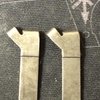...i have a gen 4 glock 35...
At least some of the G35 pistols come with the minus (3.5lb) connectors already. You'll want to check the connector to verify what you have before you buy something that may already be installed.
In the picture below, the part that is circled is the "ear" of the connector. It is shown from the right side of the gun, but you need to look at the left side of that ear to see if there is a minus sign or dash stamped into it.

Below is a picture of several connectors from the left side so you can see where the minus/dash would be stamped.

Its purpose is to maintain pressure between the trigger bar and striker, not to reset the trigger as in most other models.
It is correct that it pulls backwards (in the same direction as the trigger finger) against the trigger, but it also does perform the reset function of the trigger, albeit in a roundabout way.
The trigger spring pulls backwards and upwards on the trigger bar. The backwards pull lightens the trigger pull for the shooter, and the upwards pull on the trigger bar moves it upwards so that the striker lug will catch the rear of the trigger bar and reset the trigger. Without the trigger spring, the trigger will not reset when the slide is cycled.
Well, sorta. It turns out that if the trigger is held to the rear by the shooter while the slide is cycled, that force against the trigger will also cause it to reset due to the design of the trigger system. But, in general, without a trigger spring, the shooter will experience trigger reset issues.
There could be some failures to fully reset the trigger with the stronger trigger spring, maybe not. Or the trigger may intermittently fail the trigger safety test, or be fine.
Altering the strength of the trigger spring by making it stronger is unlikely to cause trigger reset issues--it should make trigger reset more positive.
It is also unlikely to cause issues with the trigger safety (the small piece of plastic that pivots in the trigger) until the trigger spring gets very heavy. The striker spring is a good deal stronger than the trigger spring and it would take a very strong trigger spring indeed to over power the striker spring to the point of causing issues with the trigger safety. After installing the heavier trigger spring, you can check to see if everything is still functional.
The rear of the trigger safety is a sort of flat spot that sticks out behind the trigger.
If the rear of the trigger safety is touching the frame with the trigger reset (in the forward position) then the trigger spring is too strong and should be replaced with a much lighter spring. There should be an obvious gap between the rear of the trigger safety and the frame.




